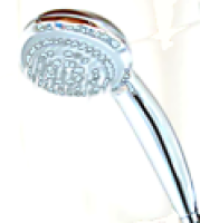Table of Contents
Shower heads
The hot water demand accounts for around 10% of the energy consumption in existing buildings. Half of this is due to losses from heating pipes, distribution and storage (see relevant section).The consumption of hot water adds up over the year - after all, it is used all year round. If it is possible to save fossil-based gas early on, on a continual basis, then the natural gas storage facilities will be charged even more in autumn, ready for the winter. For this reason, it would be worthwhile to think about measures for saving hot tap water:
- Showering less frequently or at least for shorter times (taking a full bath has a significantly higher consumption anyway). Medically, it is now undisputed that in Germany we shower too often rather than too little1).
- Water-saving shower heads are now available on the market in different designs - and they don't cost much. Unfortunately, the water flow rate (e.g. 6 l/min) is not always stated - caution is advised in the case of offers without any specific information2). For more than 10 years in our home we have only been using shower heads with a rate less than this, and have not noticed any impairment of comfort when showering.
- Note: ultimately, even a water-saving shower head will not bring any savings at all if you “compensate” taking the shower for longer periods of time.
- You can also consider saving energy with other hot water applications: turning the hot water3) tap on at the wash basin for a short time often doesn't provide any hot water service because only the (now cooled-down) water from the branch pipe comes out of the tap first. The corresponding heat loss will still be incurred because the branch pipe fills up with hot water, which cools down by the time water is next drawn from the tap.
Water flow rate in a shower can be measured easily by anyone: you only need a bucket with filling level markings (many buckets have these) and a watch showing seconds (any mobile phone with a “Timer” app). Fill the water into the bucket using the shower head and time this for 30 seconds or one minute. More than 12 l/min is too much, but even with 8 l/min it would be worthwhile to use a water-saving shower head. By the way, you can still enjoy showering with a water-saving shower head: engineers have had some good ideas for their design4)
Combination with hygiene filter
Background: Legionella
Legionella bacteria are found in potable water and can lead to illness (legionnaire's disease) if inhaled with the atomized water spray, particularly in persons with pre-existing conditions. These bacteria were discovered after the “Bellevue-Stratford-Hotel-event” in Philadelphia in 1976, there a spectacular outbreak among U.S. military veterans of the American Legion occurred. These bacteria proliferate particularly well at temperatures between 25 and 50 °C, exactly those hot water temperatures which are perceived as comfortable. However, at temperatures around 60°C these die off quickly; for this reason, supported by regulations relating to Legionella, in Germany it became common practice to keep all system components of a hot water system permanently above 60°C. On the other hand, such high temperatures naturally also result in correspondingly high permanent heat losses, especially with circulation pipes that operate 24 hours a day. A rough estimate shows that in Germany, circulation pipes account for around a half of the energy consumption for hot water (see also our article on “Thermal insulation of heat-carrying pipes”).
However, the risk is lower in small systems, such as those in most single-family homes, especially if there is regular use of hot water and if the water does not stand in the pipes for many days. For this reason, there are no binding regulations relating to minimum temperatures for these small systems. But: no-one can guarantee that transmission will not occur if temperatures drop below the 60°C threshold. Every user, including those in their own single-family house must therefore decide for themselves whether they consider the usually only substantially lower temperatures to be acceptable, e.g. in a hot water heat pump system.
Protection with high-quality legionella filter
 Now the latest filter technology can be used for protection against legionella exposure: using microfilters with opening cross-sections considerably less than 0.2 µm, it is possible to eliminate these microbes which are larger than 1 µm. These are available as so-called “terminal filters” i.e. filters directly in front of the shower head. The filtration effect has been confirmed by independent laboratory measurements.
Now the latest filter technology can be used for protection against legionella exposure: using microfilters with opening cross-sections considerably less than 0.2 µm, it is possible to eliminate these microbes which are larger than 1 µm. These are available as so-called “terminal filters” i.e. filters directly in front of the shower head. The filtration effect has been confirmed by independent laboratory measurements.
We tested one such shower head with regard to practical application:
- The shower head comes with a built-in filter and in appearance is no different from a modern “ordinary” shower head.
- It can easily be screwed on to a standard shower hose connection in place of the existing shower head. It works immediately and with a perfect result, the new shower head fits tightly. However, it might be advisable to renew the shower hose as well in any case, particularly if it is already a couple of decades old.
- We took this opportunity to measure the flow rate of the shower with a 10 litre bucket: at the middle position of the faucet (where there is a hooking point, so it is easy to reproduce such an adjustment), it took 1 minute and 41.4 seconds to fill the bucket completely. This gives a flow rate of precisely 6 litres/minute - this product is therefore simultaneously also a perfect water-saving shower head.
- Showering with this is no different from the previously used shower head: the shower feels 'full', shampoo can be washed out of the hair in a short time, the entire duration of the shower remained unchanged (as always, I needed approximately 3 minutes; such times are very different for each individual, this information has only been provided for reference).
Compared to frequently found shower heads with 12 l/min, water consumption can be reduced by around one half due to the lower flow rate5). The energy saving for usable heat (that which is made available by the shower head) is thus also halved. However, because a quite large share of the energy demand for hot water consists of circulation and storage losses, the total energy consumption is reduced “only” in the range of 25 to 30 %. In single family houses a very high level of safety can be assumed due to the terminal filter6): under these circumstances, the risk is reduced even further also with storage and circulation temperatures of 45° provided by heat pumps7).
The terminal filter inside the shower head is simply much more effective for preventing legionella exposure than permanent thermal disinfection. In this way the circulation losses can also be reduced by around 50 % compared to standard operation.
Economic aspects
Water-saving shower heads are available on the market at the same prices as conventional ones. With the lack of information for most products, the only trouble is finding suitable shower heads which make a comfortable showering experience possible also with lower flow rates.
Extra filter costs of around 100 €/a may well be incurred for a terminal legionella filter. However, the saved energy costs alone are about 125 € each year, and in addition approximately the same costs are saved for potable water.
What matters much more is the fact that such a solution allows operation of the hot water system with a commercially available hot water heat pump as well. According to our assessment, it would be reasonable to aim for a rapid switch to shower heads of the quality described here; this would reduce the number of illnesses in this connection as well as the energy consumption and thus also CO2 emissions. At the same time, the switch to heat pumps (largely renewable energy based systems) for domestic hot water will also be enabled in this way in the medium term.
Back to overview "Measures relating to building services technology"
Or to the overview relating to the building envelope.
References
| [destatis 2020] | statistics relating to traffic accidents involving motorbikes and cycles in road traffic in 2020; link to website: Traffic accidents involving motorbikes and cycles |
- Much as we would desire it, it is definitely not possible to achieve “zero risk” in many areas of our daily lives: e.g. even collisions between inattentive pedestrians can lead to serious injuries in the worst case.
- However, such “residual risks” are usually extremely low. For example, fatal accidents with bikes without the involvement of motor vehicles are less than 0.16 annually per 100.000 persons (133 persons in the year 2020 in Germany according to [destatis 2020]).
- The discussion on Corona prevention lies at the other extreme of the risks still 'considered acceptable': apparently around 100 deaths each day in Germany (that would be 44 per 100,000 people per year) seem to be regarded as 'acceptable' (we call that the 'risk standardised for 100.000 persons, r in a-1'). For comparison: in 2019 the number of fatalities in road accidents was about 4 per 100,000 people per year. The maximum estimates of the present situation relating to cases of legionnaire's disease and lung cancer due to radon gas in indoor spaces are also in the latter order of magnitude.
- With the prevention measures which we have proposed in various areas, the respective figures can be reduced by more than four times (but not to zero!): e.g. legionnaire's disease by means of the terminal filter in the shower head, or radon exposure by means of adequate ventilation of homes using balanced heat recovery ventilation systems.
- Other measures might possibly further reduce the risk slightly, but again, not to zero, unfortunately. Thus the consistent use of bicycle helmets would perhaps bring down the related standardised risk to 0.02 a-1 and we would also endorse this in view of the low effort for this. The additional increase in hot water temperatures to above 60°C generally everywhere in the system (beyond the terminal filter) in contrast would achieve a barely measurable improvement because the residual risks that still exist in this area now come mainly from the standing heated cold water; However, the effort here is huge because the heat losses are doubled. Likewise, with an additional increase in the air change rate (to 0.8 h-1, as often suggested), the radon concentrations would hardly be measurably reduced any further because according to the available measurement results with a correctly dimensioned heat recovery ventilation system, the values are already close to those of the outside air concentrations; in this example the respective effort would also be unreasonable (continuous operation of humidification systems would be necessary in winter).
- In contrast, improved infection prevention measures for example have been proven to be able to minimise the COVID risk by a factor of 4 to below 11 a-1 (wearing of masks). Or, pedestrian safety can be improved by a factor of 2 by means of speed regulation in inner cities. In these areas with a still high risk, the effort for further reductions is quite small.


